Abstract
Configuration parameters of vehicular hybrid power systems (HPSs) are critical to their economy, weight, and fuel consumption. Many marine vehicles have parameters often set based on engineering experience when designing them, which often leads to excess power from power sources, increased costs, and increased emissions. In this paper, a multi-objective optimization model, which includes the economic cost, weight, and fuel consumption, is proposed to evaluate the performance of configuration parameters. To optimize the objective optimization model, this paper adopts a genetic algorithm (GA) method to iteratively calculate the globally optimal configuration parameter results. Finally, three sets of different weight coefficients are used to verify the configuration optimization results when considering different optimization objectives. To verify the advantage of the multi-objective optimization method, the three sets of optimized results are compared to a specific configuration parameter of a marine vehicle. From the simulation results, compared with the original configuration scheme, the total economic cost of Scheme 1 is reduced by 37.25 × 104 $, the total weight is reduced by 213.55 kg, and the total fuel consumption is reduced by 163.64 t; the total economic cost of Scheme 2 is reduced by 12.2 × 104 $, the total weight is increased by 393.36 kg, and the total fuel consumption is reduced by 271.89 t; the total economic cost of Scheme 3 is reduced by 36.89 × 104 $, the total weight is reduced by 209.2 kg, and the total fuel consumption is reduced by 162.35 t.
1. Introduction
The development and utilization of energy play an important role in promoting the progress of human civilization. With the rapid development of the shipping industry and the continuous innovation of power electronics technology, China has much room for improvement in energy conservation and emission reduction, low-carbon economy, and sustainable development in the shipping field [1]. At the same time, the “National Key Energy-saving and Low-carbon Technology Promotion Catalogue (2017 Edition, Energy-saving Part)” issued by the National Development and Reform Commission of China in January 2018 pointed out that the use of key technologies such as multi-energy power assembly control and regenerative braking energy recovery enables transportation to be powered by either a diesel generator or a battery only, or both at the same time, to achieve the purpose of saving fuel and reducing consumption of the ship [2,3]. In this context, developing new green energy-saving and environmentally friendly ship hybrid power systems to meet emission reduction targets is critical.
HPSs refer to the drive system with more than one power source (such as a diesel engine, battery, fuel cell, or super capacitor). The energy management strategy (EMS) is formulated to optimize energy distribution between various power sources. Compared with the single diesel generator drive system, hybrid power systems have the advantages of low emissions, high reliability, high fuel efficiency, and long endurance mileage [4], which makes them a research hotspot in the field of transportation application around the world. This paper mainly studies the diesel-electric hybrid power system, which contains two power sources (a diesel generator and a battery pack). The diesel generator is the primary power source in the diesel-electric hybrid power system, providing electricity and daily electricity for the hybrid power system as well as charging the battery pack. The battery pack is an auxiliary power source that can provide electric energy for the hybrid system at the same time as the diesel generator and can also recycle the system’s braking energy [5,6].
Optimizing the configuration parameters of hybrid power systems is the key to improving system efficiency and fuel economy [7]. The configuration parameter optimization of multi-source power systems is to obtain optimized configuration parameters by using the optimization algorithm and considering the multi-objective optimization model under the premise of satisfying certain constraints (such as the maximum demand power of the ship, the volume and mass of the energy storage system, and so on) [8]. In recent years, more and more scholars have paid attention to hybrid power system configuration parameter optimization technology and carried out a series of studies. Graber, et al. [9] calculated the power and energy requirements of the energy storage system according to the determined energy management strategy, and then configured the number of series and parallel connections of the energy storage system based on the constraints of terminal voltage and operation demand. Herrera, et al. [10] combined internal combustion engine, battery pack and supercapacitor, and used genetic algorithm (GA) to optimize configuration parameters based on the objective function of total operating cost. Herrera, et al. [11,12] also used the traditional threshold method as the energy management strategy, and obtained the configuration guidance scheme based on GA to optimize the initial purchase cost, replacement cost, operating electricity cost and other multiple objectives under the full life cycle of the energy storage system. Jiang, et al. [13] replaced the used battery with a fully charged battery when the tram entered the station, and considered the economic cost of the ground charging station required in the construction process and the operating cost economy under the full life cycle using an optimization algorithm. The above references mainly take economic cost as a single objective to optimize configuration parameters. Due to the severe international energy situation and the development requirements of lightweight rail transit, it is obvious that considering the economic cost alone does not meet the needs of configuration optimization. Therefore, this paper proposes a multi-objective configuration optimization model that comprehensively considers economy, weight and fuel consumption, and uses GA to globally optimize the multi-objective function. Compared with other global optimization algorithms (such as PSO), due to the crossover and mutation conditions set by GA itself, it has the advantages of faster calculation speed and better convergence in the iterative calculation of multi-objective optimization function composed of economy, weight and fuel consumption.
The main contributions of this paper are:
- ◼
- Comprehensively consider economy, weight and fuel consumption to build a multi-objective optimization model, which is more in line with the low cost, lightweight and energy saving and emission reduction requirements of shipbuilding
- ◼
- GA is used to design the configuration scheme of the multi-objective optimization model. Compared with other heuristic algorithms (such as PSO), GA has faster convergence speed and better convergence
- ◼
- By setting several groups of different weight coefficients and comparing the original scheme and the single objective optimization scheme, the wide range optimization characteristics of the multi-objective optimization model proposed in this paper are verified
- ◼
- Providing a dynamic simulation comparation of optimization scheme and original scheme in order to verify the performance of these optimization schemes.
2. Configuration Optimization Model of Hybrid Power System
Optimizing the configuration parameters of a ship hybrid power system can significantly improve the economy and reliability of system operation on the basis of ensuring its dynamic performance [14]. This paper focuses on the optimization of the configuration parameters of a ship power system. Based on the establishment of a multi-objective configuration optimization model of a power system, some constraints are added, and a weighting function is introduced to give a total evaluation function to comprehensively evaluate the matching effect of ship parameters. Finally, a GA method is used to solve the optimal configuration scheme to achieve the multi-objective optimization design of economy, weight, and fuel consumption of the hybrid system.
2.1. Topology of Hybrid Power System
The topology of the hybrid system studied in this paper is shown in Figure 1. The system includes the following main modules: diesel generator set, AC/DC rectifier, power battery pack, DC/DC converter, DC/AC inverter and loads [15].
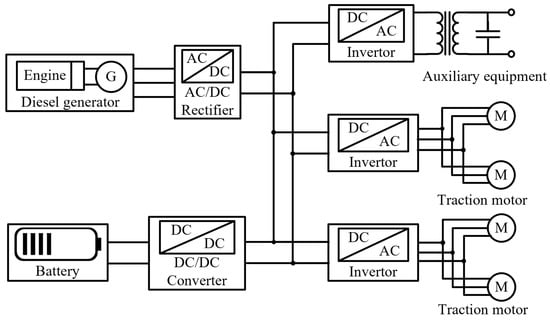
Figure 1.
Topological structure of hybrid system.
The diesel generator is mainly composed of a diesel engine and a permanent magnet synchronous generator, which is connected to the DC bus through an AC/DC converter [16]. The battery pack outputs direct current, which is fed into the DC bus through a bidirectional DC/DC converter. The charging and discharging efficiency are 0.97 and 0.985, respectively. The bidirectional DC/DC converter can flexibly adjust the bidirectional transmission of energy according to the operating conditions of the ship. Not only can it be used as a power source to supply power to the load, but it can also realize the recycling of ship regenerative braking energy [17]. The other side of the DC bus is connected to an auxiliary inverter and a traction inverter, respectively. The auxiliary inverter provides power for auxiliary electrical equipment such as air conditioners and headlights, and the traction inverter supplies power for the traction motor to drive propellers [18,19].
2.2. Multi-Objective Configuration Optimization Model of Hybrid Power System
The efficient operation of the hybrid power system depends on the reasonable match between the components of the power system and the good control strategy [20]. Optimizing the configuration parameters of the power system is to optimize the relevant parameters of the power components under the premise of satisfying various constraints. Under certain cycle conditions, the ship aims to save economic costs, reduce the weight of the system, reduce fuel consumption, reduce the total amount of exhaust emissions, and achieve multiple objective functions that may conflict with each other. In the feasible region, it is possible to achieve the best at the same time. The optimization model has the characteristics of being nonlinear, multi-dimensional, multi-constraint, and non-differentiable [21]. Therefore, the configuration optimization model of a hybrid power system is a typical multi-objective optimization problem, as shown in (1).
where, is the decision vector; is the objective vector; and are the number of inequality constraints and equality constraints that the objective function needs to satisfy.
In order to quantitatively evaluate the advantages and disadvantages of different parameter configuration schemes of the hybrid power system, this paper selects the economic cost, weight, and diesel consumption of the whole life cycle of the hybrid power system as the optimization objectives and establishes the corresponding mathematical model, as shown in Figure 2. The multi-objective configuration optimization model of a marine hybrid power system is divided into three parts: economic model, weight model, and fuel consumption model. The economic model mainly contains the initial purchase cost, replacement cost, operation cost. Since the proportion of the power converter is very small, the weight model mainly includes diesel generator and battery pack. The fuel consumption model mainly presents the fuel characteristic of the diesel generator. The calculations of each model and system component are presented in this figure, and they are explained in detail below. Since the ship‘s drive system (including DC/AC converts and loads) is determined according to the ship type, configuration optimization cannot be performed. Therefore, the sources and microgrid are mainly taken into consideration when optimizing the configuration of the ship‘s hybrid power system. Details are as follows.
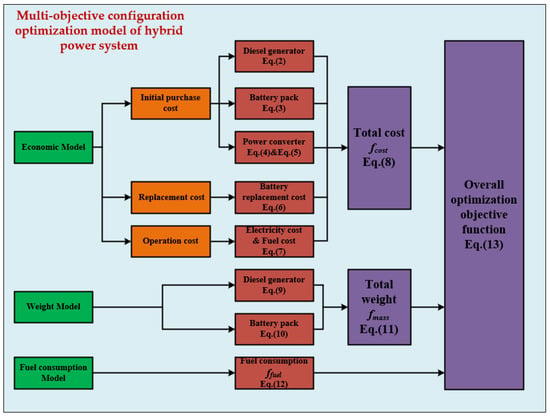
Figure 2.
The flow chart calculation of a multi-objective optimization model.
2.2.1. Economic Model of Hybrid Power System
The economic model of the hybrid power system established in this paper includes three main parts: initial purchase cost, replacement cost and operation cost [22].
- Initial purchase cost
The initial purchase cost is the cost required to purchase the diesel generator, AC/DC converters, power battery packs, and DC/DC converters.
- (1)
- Initial purchase cost of diesel generator
The price information of diesel engines used in the shipping industry is generally not disclosed to the public, so it is difficult to obtain its specific amount directly. It is known that the greater the power of the diesel engine is, the greater its volume, weight, and price are, in other words, there is a positive correlation. Therefore, according to the maximum output power of the diesel engine group and its corresponding initial purchase price information, the initial purchase cost of the required diesel generator set can be calculated by the fitting method, as shown in (2):
where CostDG is the initial purchase cost of the diesel generator; PDG_max is the maximum output power of the diesel engine; k1, k2, and k3 are coefficient of fitting function which are fitted as 6.502 × 10−5, 0.01274, and 2.93.
- (2)
- Initial purchase cost of battery pack
The initial purchase cost of the battery pack is the product of the unit price of the battery and the total power of the battery pack, as shown in (3).
where Costbat is the initial purchase cost of battery pack; Costbat_unit is the single price of the battery and its unit is 104 $/kW·h, which is set as 0.21 × 104 $/kW·h; mbat and nbat are the number of series and parallel connection batteries; Qbat and Ucell are the capacity and voltage of the single battery.
- (3)
- Initial purchase cost of AC/DC converters
The initial purchase cost of AC/DC converters is calculated by (4):
where CostAC/DC is the initial purchase cost of AC/DC converters; PAC/DC_max is the maximum output power of AC/DC converters; CostAC/DC_unit is the single price of AC/DC converters and its unit is 104 $/kW, which is set as 0.0069 × 104 $/kW.
- (4)
- Initial purchase cost of DC/DC converters
Similar to AC/DC converters, the initial purchase cost of DC/DC converters is shown in (5):
where CostDC/DC is the initial purchase cost of DC/DC converters; PDC/DC_max is the maximum output power of DC/DC converters; CostDC/DC_unit is the single price of DC/DC converters and its unit is 104 $/kW, which is set as 0.0055 × 104 $/kW. It is worth noting that the single prices of battery pack, DC/DC converter and AC/DC converter (Costbat_unit, CostDC/DC_unit, and CostAC/DC_unit) are provided by the device supplier, and the value quotation in this paper is provided by CSCC. When implementing the relevant design, ship manufacturers can reasonably select suppliers according to their own needs.
- 2.
- Replacement cost
The diesel generator and battery pack in the hybrid power system are affected by factors such as working conditions, shelving time, frequency of use, and ambient temperature [23]. In order to ensure the normal operation of the ship throughout its working life, it is necessary to check the battery pack and diesel generator regularly [24]. If there are safety hazards and it cannot be repaired, it needs to be purchased and replaced immediately. This part of the cost should also be considered in the cost of the full operating life of the hybrid system. Among them, the diesel generator has a long life, which can basically meet the functional requirements of the whole life range of the hybrid power system. However, with the increase in the use time of the battery pack, the charge and discharge times of the battery pack also increase accordingly, which will reduce the capacity of the battery pack. When the capacity is reduced to 80% of the initial value, it can be considered that the battery pack does not meet the demand and needs to be replaced in time.
The replacement cost of the battery pack is the product of the total number of battery replacements in the full life cycle of the hybrid system and the initial purchase cost, as shown in (6):
where Costchange is the replacement cost of the battery pack; N is the total number of battery replacements in the whole life cycle; Costbat is the initial purchase cost of the battery pack.
- 3.
- Operation cost
As shown in (7), the operating costs mainly include fuel costs and electricity costs:
where Costoperate is the total operation cost; T is the whole life cycle of ships; M is the number of ship voyages per year; Costelec is the electric cost for single voyage of ships; FC is the fuel consumption for single voyage of ships; Costfuel is the unit price of diesel fuel.
From the above, the economic model of the hybrid power system can be obtained as shown in (8):
2.2.2. Weight Model of Hybrid Power System
Compared with the mass of diesel generator, battery pack and other equipment, the mass proportion of power converters is very small and the overall optimization effect will not be affected during configuration optimization. Therefore, only the diesel generator and battery pack are considered for weight optimization in this paper. The weight model of a hybrid power system is mostly divided into two parts: the total weight of the diesel generator and the battery [25].
- (1)
- Total weight of diesel generator
Referring to the fitting method of the initial purchase cost of the diesel generator (Equation (2)), the function is also fitted according to the maximum output power of the existing diesel generator and its corresponding weight as shown in (9), and the weight of the diesel generator under different maximum output power can be obtained by bringing it into the calculation:
where MassDG is the total weight of diesel generator; k4, k5, and k6 are the coefficient of fitting function.
- (2)
- Total weight of battery pack
The total weight of the battery pack is the product of the weight of the single battery and the total number of batteries series and parallel, as shown in (10):
where Massbat is the total weight of the battery pack; Massbat_unit is the weight of the single battery.
From the above, the weight model of the hybrid system is shown in (11):
2.2.3. Fuel Consumption Model of Hybrid System
Although fuel consumption has been considered in Equation (7), in order to avoid the excessive battery size caused by the reduction of fuel consumption, which will affect the initial purchase cost of the battery and the total economic cost of the ship, fuel consumption is considered separately in this paper. In order to quantitatively evaluate the energy saving and emission reduction effects of a power system, the fuel consumption model of the power system is established as shown in (12):
where T is the whole life cycle of ships; M is the number of ship voyages in per year; FC is the fuel consumption per voyage of ships.
2.2.4. Overall Optimization Objective Function and Constraint Conditions
The three configuration optimization evaluation models of economy (fcost), weight (fmass), and fuel consumption (ffuel) established above can quantitatively evaluate the effects of a diesel-electric hybrid power system in three different configuration directions. For different types or conditions of ship operation lines, these three evaluation objectives are valued differently. Therefore, this paper uses the weight coefficient transformation method to characterize the importance of each optimization objective by introducing the weight coefficient wi and setting the overall optimization objective function of the dynamic system, as shown in (13):
where w1, w2, and w3 are the weight coefficients of economy, weight and fuel consumption. The weight coefficient should satisfy non-negativity and normality, namely and ; fcost_max, fmass_max, and ffuel_max are the maximum values for each optimization objective which is calculated by the existing hybrid system matching parameters.
When optimizing the parameter configuration, it is also necessary to consider the constraints shown in (14):
where SOCbat is the battery state of charge; SOCbat_max and SOCbat_min are the upper and lower limits of SOC; Ibat is the output current of the battery; Ibat_max is the upper limit of battery output current; Ubat is the output voltage of the battery; Ubat_max and Ubat_min are the upper and lower limits of the battery voltage; Vbat is the volume of battery; Vbat_max is the upper limit of battery volume; mbat is the weight of the battery; mbat_max is the upper of battery weight; mDG is the weight of the diesel generator; mDG_max is the upper limit of diesel generator weight.
3. Configuration Parameter Optimization Based on GA Method
The difficulty of a multi-objective global optimization problem increases with the number of parameters to be optimized, so in general, only the parameters that can dominate system performance are selected as the optimization objects [18,26]. In this paper, the following three parameters are selected as configuration parameters affecting the performance of the hybrid power system: the number of series (m), parallel (n), and maximum output power of diesel generators. The value range of the parameters to be optimized is shown in Table 1. On the premise of meeting the basic demand power and demand energy of the hybrid power system running on the established line, this paper uses the GA method to optimize the above three configuration parameters, and completes the multi-objective optimization design of the economy, weight, and fuel consumption of the power system, so as to achieve the goal of reducing cost, saving energy, and reducing pollutant emissions.

Table 1.
Related parameters in the optimization variables.
3.1. Implementation of GA Method
The basic steps of using the GA method to optimize the configuration parameters of a hybrid system are as follows [27]:
- (1)
- Set the running parameters of the GA method. The operating parameters include the population size M, the number of variables n, the crossover probability pc, the mutation probability pm, and the termination evolution algebra G of the genetic operation. The specific parameters are shown in Table 2.
- (2)
- Establish a feasible solution region. According to the constraints of the parameters to be optimized in this paper, the value range of each variable in the algorithm is set.
- (3)
- Coding. According to the characteristics of the solution of the optimization of the configuration parameters of the hybrid power system, the three parameters m, n, and PDG_max to be optimized are encoded into three genes of the X chromosome. That is , each X chromosome is a population individual of the GA method.
- (4)
- Generate the initial population. Randomly generate M individuals Xi (i = 1, 2, …, M) as the initial population P(0), that is, randomly generate m, n, and PDG_max within the range of values.
- (5)
- Evaluate fitness. Substitute the fitness function to calculate the fitness value of each individual in the population P(t), that is, the objective function value J.
- (6)
- Select the operation. According to the individual’s fitness value, this paper uses the conventional roulette selection method to select each individual in the population P(t), and directly inherits the high-quality individual to the next generation or retains it to perform the next operation.
- (7)
- Cross-operation. For the high-quality individuals retained in the selection operation, this paper uses the weighted average crossover method to perform the crossover operation with probability pc.
- (8)
- Mutation operation. In this paper, the uniform mutation method is used to perform the mutation operation with probability pm. The next generation population P(t + 1) is obtained after selection, crossover, and mutation operations of population P(t).
- (9)
- Determine the termination condition. In this paper, evolutionary algebra is used as the condition of algorithm termination. If the termination condition is not met, go to step (4); if the termination condition is satisfied, the individual value x* = [m, n, PDG_max] with the minimum objective function value obtained in the evolution process is used as the optimal solution output of the configuration parameter to terminate the operation.

Table 2.
Operating parameters of GA.
Table 2.
Operating parameters of GA.
| Symbol | Population Size | Variable Quantity | Cross Probability | Mutation Probability | Termination of Evolutionary Algebra |
|---|---|---|---|---|---|
| Value | 50 | 3 | 0.4 | 0.01 | 200 |
After optimization, the optimal values of the three configuration parameters are substituted into the economic model, weight model, and fuel consumption model of the power system, and the target values can be obtained to complete the whole optimization process [28,29]. The overall process is shown in Figure 3.
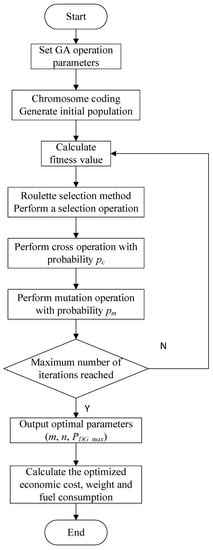
Figure 3.
Flow diagram of optimizing configuration parameters based on GA.
3.2. Analysis of Configuration Optimization Results
According to the three optimization objectives of the study, this paper selects three schemes of different weight coefficients for optimization. As shown in Table 3, w1, w2, and w3 are the weight coefficients of economy, weight, and fuel consumption, respectively. As can be seen from the table, Scheme 1 of weight coefficients equal emphasis on economy (w1) and energy saving (w3); Scheme 2 of weight coefficients does not attach importance to economic costs, with energy saving as the first goal; Scheme 3 of weight coefficients does not pay attention to energy saving and emission reduction, with economic cost as the first. Decision makers therefore pay more attention to which target can choose the corresponding optimization scheme.

Table 3.
Values of three schemes of weight coefficients.
In this paper, a ship life cycle load profile (about 20,594 s) is used as the single load profile of the ship in the configuration optimization, and based on this, multi-objective optimization is carried out, as shown in Figure 4. Based on this load profile of the designed ship, operation cost, fuel consumption, and other optimization objectives can be calculated.
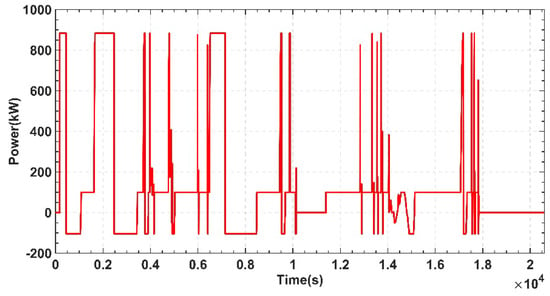
Figure 4.
Single load profile of the designed ship.
The GA method is used to optimize the multi-objective optimization functions under the three schemes of weight coefficients. After optimization, the iterative convergence process of the fitness function value and the optimal individual with the minimum objective function value can be output at the same time. The corresponding optimization results in three groups of weight coefficients are shown in Figure 5, Figure 6 and Figure 7. In the optimization process, the optimization variable 1 is the number of batteries in series, the optimization variable 2 is the number of batteries in parallel, and the optimization variable 3 is the maximum output power of diesel generators.
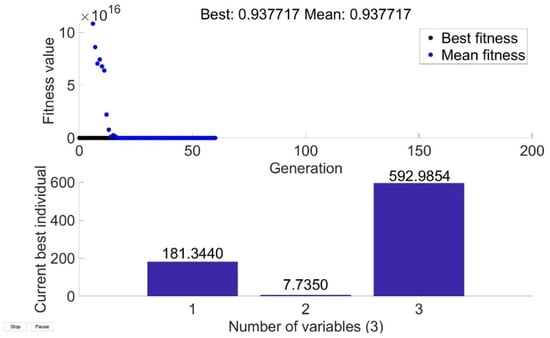
Figure 5.
Configuration optimization results of Scheme 1’s weight coefficients.
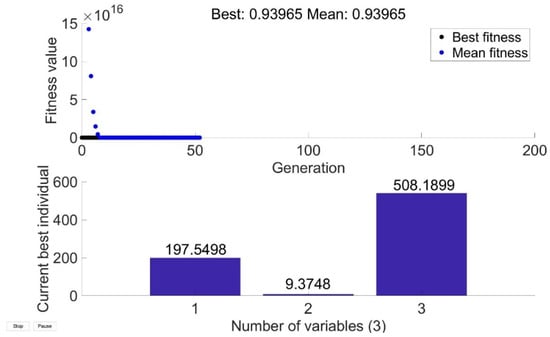
Figure 6.
Configuration optimization results of Scheme 2’s weight coefficients.
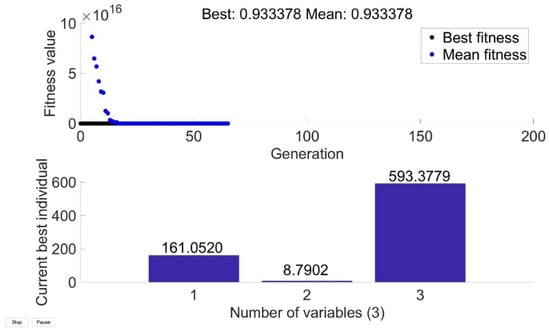
Figure 7.
Configuration optimization results of Scheme 3’s weight coefficients.
From Figure 5, the optimal value of the overall objective function corresponding to Scheme 1 of weight coefficients is 0.937717; the optimization variable 1 is 181.3440, rounded up to obtain the optimal number of batteries in series is 182; the optimization variable 2 is 7.7350, and the number of parallel batteries that can be optimized is 8. Optimization variable 3 is 592.9854, rounded up to get the maximum output power of diesel generators optimized 593 kW. Therefore, the configuration optimization Scheme 1 obtained using the GA method can be expressed as 182S/8P/593 kW. Using the same method for Scheme 2 and Scheme 3, the configuration optimization Scheme 2 is 198S/10P/509 kW and the configuration optimization Scheme 3 is 162S/9P/594 kW, as shown in Table 4.

Table 4.
Parameters of existing configuration and three schemes of optimized configuration.
According to the above parameters, the economic cost, weight, and fuel consumption of the existing configuration scheme and the three optimal configuration schemes of the hybrid system are calculated, as shown in Table 5.

Table 5.
Target values of existing configuration and optimized configuration.
It can be seen from Table 5 that the total economic cost of the hybrid power system under the existing configuration scheme of 180S/6P/735 kW is 478.68 × 104 $, the total weight of the system is 7305.60 kg, and the total fuel consumption is 2518.22 t. Taking the existing configuration as the benchmark of per-unit calculation, when the target weight coefficients are 0.4, 0.2, and 0.4, respectively, the total economic cost of the optimal configuration Scheme 1 (182S/8P/593 kW) obtained by GA optimization is reduced by 37.25 × 104 $ compared with the existing configuration, the total weight of the system is reduced by 213.55 kg compared with the existing configuration, and the total fuel consumption is reduced by 163.64 t compared with the existing configuration. When the weight coefficient values of each target are 0.1, 0.2 and 0.7, respectively, the total economic cost of the optimized configuration Scheme 2 (198S/10P/509 kW) is reduced by 12.2 × 104 $ compared with the existing configuration, the total weight of the system is increased by 393.36 kg compared with the existing configuration, and the total fuel consumption is reduced by 271.89 t compared with the existing configuration. When the weight coefficient values of each target are 0.7,0.2 and 0.1, respectively, the total economic cost of the optimized configuration Scheme 3 (162S/9P/594 kW) is reduced by 36.89 × 104 $ compared with the existing configuration, the total weight of the system is reduced by 209.2 kg compared with the existing configuration, and the total fuel consumption is reduced by 162.35 t compared with the existing configuration.
In order to verify the rationality of multi-objective function optimization, this paper conducts single objective configuration optimization for economy, weight and fuel consumption, and the optimization results are shown in Figure 8, Figure 9 and Figure 10. From the Figure 8, the maximum power of the diesel generator is the greatest compared with other multi-objective schemes. This verifies that the purchase cost of other devices such as batteries can be reduced by increasing the output power of diesel engines, but this will increase fuel consumption. Figure 9 shows that the number of battery pack is lower than other multi-objective schemes, and this configuration optimization scheme, which only considers the weight, reduces the power configuration of the power source as much as possible on the premise of meeting the requirements of the working conditions. Figure 10 shows the configuration result which only optimizes the fuel consumption. It can be seen that the maximum power of diesel generator is lower than other schemes, and the capacitor of battery pack is the largest. This configuration scheme reduces the fuel consumption of diesel generator by increasing the power output proportion of the battery pack, but it is not conducive to the optimization of the economy and weight of the marine vehicle.
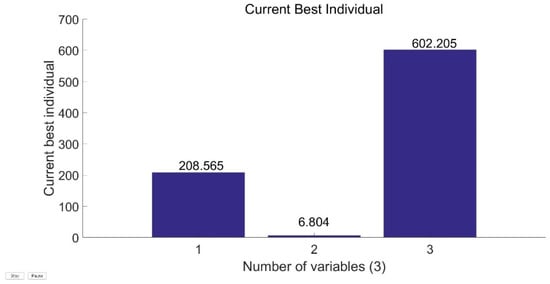
Figure 8.
Configuration optimization result of the single economy.
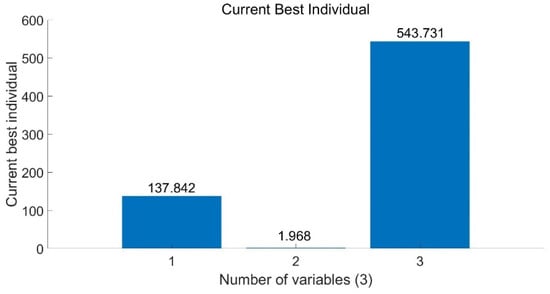
Figure 9.
Configuration optimization result of the single weight.
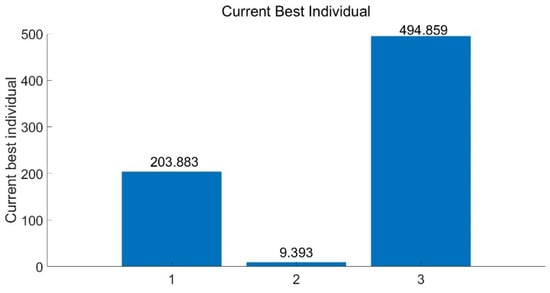
Figure 10.
Configuration optimization result of the single fuel consumption.
In this paper, GA is used to optimize the configuration parameters of the hybrid power system, and three sets of optimized configuration schemes are obtained. In order to reflect the superiority of GA to the multi-objective optimization model proposed in this paper, this paper adds the optimization results of particle swarm optimization (PSO) algorithm. In order to better compare the results of the two optimization algorithms, the weight coefficients of the multi-objective function of the PSO algorithm are selected as 0.4, 0.2, and 0.4, and the optimization results are shown in Figure 11.
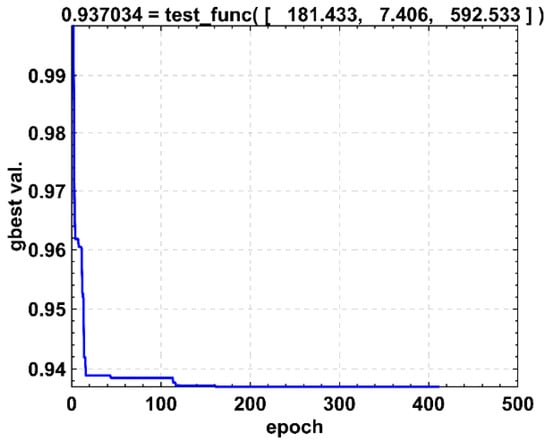
Figure 11.
Results of configuration by PSO algorithm.
From the PSO algorithm optimization results, it can be seen that for the overall objective function with weight coefficients of 0.4, 0.2 and 0.4, the optimal value is 0.9370; the optimization variable 1 is the number of batteries in series, and the optimal value is 181.433. The number of batteries in series can be optimized by rounding up to 182. The optimization variable 2 is the number of parallel battery pack, and the optimal value is 7.406, rounded up to optimize the number of parallel batteries is 8; the optimization variable 3 is the maximum output power of the diesel generator. The optimal value is 592.37. The maximum output power of the optimized diesel generator set is 593 kW. The optimal configuration scheme obtained by PSO algorithm can be expressed as 182S/8P/593 kW.
Compared with the first optimal configuration scheme obtained by GA under the same weight coefficient, it can be concluded that under the same weight coefficient, the parameters of the optimal configuration scheme obtained by GA and particle swarm optimization algorithm are the same, so the economic cost, weight and fuel consumption of the two schemes are the same. It is shown that the two algorithms have basically the same optimization effect for the optimization design of the configuration parameters of the fuel-electric hybrid power system studied in this paper, which confirms the correctness of the optimization algorithm. At the same time, it can be seen from Figure 5 and Figure 11 that the GA converges after about 20 iterations, while the PSO converges after about 110 iterations, so the GA converges faster. This shows that compared with other heuristic algorithms such as PSO, GA has better and faster convergence characteristics due to its own crossover and mutation characteristics.
In order to verify the performance of these optimization schemes, this paper provides a dynamic simulation comparation of Scheme 3 and the original scheme. Figure 12 and Figure 13 show the power distribution under the two schemes based on same energy management strategy and load profile. The SOC range of battery pack is set as [0.2,0.9]. When SOC is lower than 0.2, the battery pack needs to be charged and the power of battery is negative (such as in 9000 s). From these figures, it can be seen that the power of diesel generator and battery pack are the same as their configuration schemes. It verifies that the scheme obtained from configuration optimization meets the requirements of marine operation conditions.
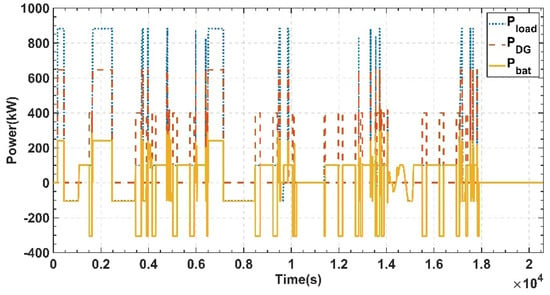
Figure 12.
Power distribution characteristics of the original scheme.

Figure 13.
Power distribution characteristics of Scheme 3.
In order to verify the fuel saving effect of the configuration optimization Scheme 3 under the same energy management strategy and working conditions, we compared the fuel consumption of this scheme with that of the original scheme, as shown in Figure 14. According to the simulation results, the optimized configuration Scheme 3 can save 8.4558 kg fuel consumption under each load profile.
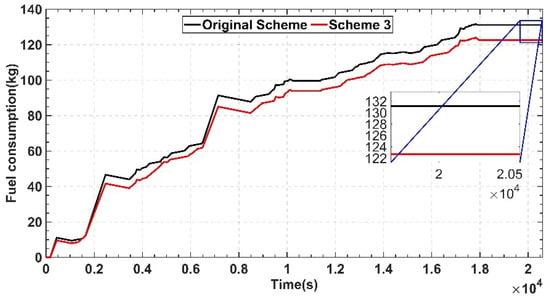
Figure 14.
Fuel consumption under two schemes.
The following conclusions can be drawn:
Firstly, the economy and fuel consumption of the three optimal configuration schemes obtained under the three sets of weight coefficients are better than the existing configuration, which can achieve the goal of cost saving, energy saving, and emission reduction, and verifies the feasibility and correctness of using the GA method to solve the multi-objective optimization problem of hybrid power systems.
Secondly, in the three optimal configuration schemes, the fuel consumption of optimal configuration Scheme 2 is the lowest, but its total economic cost is higher at the same time, which verifies the demand that the economic cost is not considered when setting the weight coefficient and the energy saving and emission reduction is the first goal.
Thirdly, although the optimal configuration Scheme 3 does not consider energy loss and emission reduction when setting the weight coefficient and takes the economic goal as the most important, because the economic model of the power system considers the operating cost based on the fuel cost, the weight coefficient of the fuel consumption is set to 0.1 at this time. It will lead to higher fuel consumption, so that the economic cost will increase accordingly. In this case, the GA method will try to balance the two optimization objectives of economic cost and fuel consumption in the process of optimization and try to search for the global optimal solution. Therefore, the optimization result of Scheme 3 is similar to that of Scheme 1, and the global optimization ability of the GA method is verified.
Finally, the three optimal configuration schemes obtained for the three groups of different weight coefficients have their own advantages. When designing a new marine, which optimization goal is more important can be selected accordingly, which provides more choices for decision makers under the premise of ensuring the realization of the optimization goal of hybrid system configuration.
4. Conclusions
The performance of a marine hybrid power system is directly decided by its configuration parameters. This study presents a case of marine hybrid power system (including DG, battery, power converters, and loads) to study the configuration parameter optimization of the system. In order to optimize the configuration parameters, this paper also proposes a multi-objective configuration optimization model. Based on the optimization model, a GA method is proposed to optimize the multi-objective function with fixed weight coefficients. The main findings are as follows:
- (1)
- The multi-objective configuration optimization model directly affected the performance of the configuration parameter optimization results. In this study, the optimization objectives of the hybrid power system include economics, weight, and fuel consumption. The multi-objective optimization model is also divided into three parts: the economic model, the weight model, and the fuel consumption model. This model can truly evaluate the rationality of a hybrid power system to meet the actual configuration requirements.
- (2)
- The GA method is proposed to optimize the multi-objective optimization function. In the optimized simulation, three different sets of weight coefficient, which represent different optimization objectives focus, are simulated to compare with a real configuration parameter set.
Furthermore, the proposed multi-objective optimization is advantageous. The proposed GA method can provide a global optimization for different weight coefficient sets. In the process of studying multi-objective configuration optimization of hybrid power system, this paper adopts the method of setting different weight coefficients for configuration optimization. This optimization method contains the designer’s personal preference information for each optimization objective. Each optimization process can only obtain a single optimal solution, and more optimal solutions can be obtained by changing the weight coefficient, that is, more different optimal configuration schemes can be obtained. In consideration of the fact that engineering applications may also require more optimal solutions at one time, we can further study how to directly obtain an optimal solution set through optimization algorithms, so that ship manufacturers can directly select the most satisfactory solution from the optimal solution set.
Author Contributions
Conceptualization, Y.Z.; data curation, L.D. and C.X.; formal analysis, J.Z. and Y.Z.; funding acquisition, L.D.; investigation, Y.Z.; methodology, Q.W.; resources, H.P. and L.H.; supervision, X.L. and Y.Q. All authors have read and agreed to the published version of the manuscript.
Funding
The research was financially supported by China’s National Key R&D Program (2021YFB2601300).
Institutional Review Board Statement
Not applicable.
Informed Consent Statement
Not applicable.
Data Availability Statement
Not applicable.
Conflicts of Interest
The authors declare no conflict of interest.
References
- Huang, B.; Hu, M.; Zeng, L.; Fu, G.; Jia, Q. Design Method for Hybrid Electric Vehicle Powertrain Configuration with a Single Motor. Sustainability 2022, 14, 8225. [Google Scholar] [CrossRef]
- Tan, J.; Wang, X.; Polinder, H.; Laguna, A.J.; Miedema, S.A. Downsizing the Linear PM Generator in Wave Energy Conversion for Improved Economic Feasibility. J. Mar. Sci. Eng. 2022, 10, 1316. [Google Scholar] [CrossRef]
- Wang, Z.; Wang, D.; Zhao, F.; Han, F.; Ji, Y.; Cai, W. Hydrogen Refueling Stations and Carbon Emission Reduction of Coastal Expressways: A Deployment Model and Multi-Scenario Analysis. J. Mar. Sci. Eng. 2022, 10, 992. [Google Scholar] [CrossRef]
- Ehsani, M.; Singh, K.V.; Bansal, H.O.; Mehrjardi, R.T. State of the Art and Trends in Electric and Hybrid Electric Vehicles. Proc. IEEE 2021, 109, 967–984. [Google Scholar] [CrossRef]
- Yan, J.; Gao, S.; Zhao, W.; Lee, T.H. Study of combustion and emission characteristics of a diesel engine fueled with diesel, butanol-diesel and hexanol-diesel mixtures under low intake pressure conditions. Energy Convers. Manag. 2021, 243, 114273. [Google Scholar] [CrossRef]
- Kondili, E.; Kaldellis, J.K. Design and performance optimization of hybrid energy systems. In Computer Aided Chemical Engineering; Pistikopoulos, E.N., Georgiadis, M.C., Kokossis, A.C., Eds.; Elsevier: Amsterdam, The Netherlands, 2011; Volume 29, pp. 1778–1783. [Google Scholar]
- Wang, Y.; Liu, C.; Cai, C.; Ma, Z.; Zhou, M.; Dong, H.; Li, F. Bi-Level Planning Model for Urban Energy Steady-State Optimal Configuration Based on Nonlinear Dynamics. Sustainability 2022, 14, 6485. [Google Scholar] [CrossRef]
- Zhou, X.; Shou, J.; Cui, W. A Game-Theoretic Approach to Design Solar Power Generation/Storage Microgrid System for the Community in China. Sustainability 2022, 14, 10021. [Google Scholar] [CrossRef]
- Graber, G.; Galdi, V.; Calderaro, V.; Piccolo, A. Sizing and energy management of on-board hybrid energy storage systems in urban rail transit. In Proceedings of the 2016 International Conference on Electrical Systems for Aircraft, Railway, Ship Propulsion and Road Vehicles & International Transportation Electrification Conference (ESARS-ITEC), Toulouse, France, 2–4 November 2016; pp. 1–6. [Google Scholar]
- Herrera, V.I.; Milo, A.; Gaztanaga, H.; Camblong, H. Multi-Objective Optimization of Energy Management and Sizing for a Hybrid Bus with Dual Energy Storage System. In Proceedings of the 2016 IEEE Vehicle Power and Propulsion Conference (VPPC), Hangzhou, China, 17–20 October 2016; pp. 1–6. [Google Scholar] [CrossRef]
- Herrera, V.I.; Gaztañaga, H.; Milo, A.; Saez-de-Ibarra, A.; Etxeberria-Otadui, I.; Nieva, T. Optimal energy man-agement of a battery-supercapacitor based light rail vehicle using genetic algorithms. In Proceedings of the 2015 IEEE Energy Conversion Con-gress and Exposition (ECCE), Montreal, QC, Canada, 20–24 September 2015; pp. 1359–1366. [Google Scholar]
- Herrera, V.I.; Gaztanga, H.; Milo, A.; Nieva, T.; Etxeberria-Otadui, I.; Isaac, H.V.; Haizea, G.; Aitor, M.; Txomin, N.; Ion, E.-O. Optimal Operation Mode Control and Sizing of a Battery-Supercapacitor Based Tramway. In Proceedings of the 2015 IEEE Vehicle Power and Propulsion Conference (VPPC) 2015, Montreal, QC, Canada, 19–22 October 2015; pp. 1–6. [Google Scholar] [CrossRef]
- Jiang, J.; Long, C.; Acuna, P.; Fulai, A.; Sijia, Y.; Shanshan, Z. Fast-swap charging mode: An operation mode for on-board-powered light rail networks. In Proceedings of the 2017 11th IEEE International Conference on Compatibility, Power Electronics and Power Engineering (CPE-POWERENG), Cadiz, Spain, 4–6 April 2017; pp. 477–482. [Google Scholar]
- Nguyen, H.T.; Safder, U.; Nguyen, X.N.; Yoo, C. Multi-objective decision-making and optimal sizing of a hybrid renewable energy system to meet the dynamic energy demands of a wastewater treatment plant. Energy 2020, 191, 116570. [Google Scholar] [CrossRef]
- Zhang, Y.; Xu, C.; Pei, H.; Li, L. Dual-Mode DC/DC Converter for Multi-energy Drive System. In Proceedings of the 5th International Conference on Electrical Engineering and Information Technologies for Rail Transportation (EITRT) 2021, Qingdao, China, 22–24 October 2021; Springer: Singapore, 2022; pp. 127–134. [Google Scholar]
- Zhang, B.; Jiang, Y.; Chen, Y. Research on Calibration, Economy and PM Emissions of a Marine LNG–Diesel Dual-Fuel Engine. J. Mar. Sci. Eng. 2022, 10, 239. [Google Scholar] [CrossRef]
- Pei, H.; Zhang, Y.; Li, W.; Li, L.; Diao, L. An Estimation Method for Replacement Cost of Multi-energy Drive System. In Proceedings of the 5th International Conference on Electrical Engineering and Information Technologies for Rail Transportation (EITRT) 2021, Qingdao, China, 22–24 October 2021; Springer: Singapore, 2022; pp. 164–171. [Google Scholar]
- Gholami, M.; Shahryari, O.; Rezaei, N.; Bevrani, H. Optimum storage sizing in a hybrid wind-battery energy system considering power fluctuation characteristics. J. Energy Storage 2022, 52, 104634. [Google Scholar] [CrossRef]
- Zhou, X.; Abdelkhalik, O.; Weaver, W. Power Take-off and Energy Storage System Static Modeling and Sizing for Direct Drive Wave Energy Converter to Support Ocean Sensing Applications. J. Mar. Sci. Eng. 2020, 8, 513. [Google Scholar] [CrossRef]
- Zhao, H.; Xu, J.; Xu, K.; Sun, J.; Wang, Y. Optimal Allocation Method of Source and Storage Capacity of PV-Hydrogen Zero Carbon Emission Microgrid Considering the Usage Cost of Energy Storage Equipment. Energies 2022, 15, 4916. [Google Scholar] [CrossRef]
- Cai, W.; Li, X.; Maleki, A.; Pourfayaz, F.; Rosen, M.A.; Nazari, M.A.; Bui, D.T. Optimal sizing and location based on economic parameters for an off-grid application of a hybrid system with photovoltaic, battery and diesel technology. Energy 2020, 201, 117480. [Google Scholar] [CrossRef]
- Xie, C.; Wang, D.; Lai, C.S.; Wu, R.; Wu, X.; Lai, L.L. Optimal sizing of battery energy storage system in smart mi-crogrid considering virtual energy storage system and high photovoltaic penetration. J. Cleaner Prod. 2021, 281, 125308. [Google Scholar] [CrossRef]
- Naseri, F.; Barbu, C.; Sarikurt, T. Optimal sizing of hybrid high-energy/high-power battery energy storage systems to improve battery cycle life and charging power in electric vehicle applications. J. Energy Storage 2022, 55, 105768. [Google Scholar] [CrossRef]
- Li, X.; Jones, G. Optimal Sizing, Location, and Assignment of Photovoltaic Distributed Generators with an Energy Storage System for Islanded Microgrids. Energies 2022, 15, 6630. [Google Scholar] [CrossRef]
- Quan, X.; Xie, H.; Wang, X.; Zhang, J.; Wei, J.; Zhang, Z.; Liu, M. Optimization and Performance Analysis of a Distributed Energy System Considering the Coordination of the Operational Strategy and the Fluctuation of Annual Hourly Load. Appl. Sci. 2022, 12, 9449. [Google Scholar] [CrossRef]
- Chatterjee, A.; Rayudu, R. Techno-economic analysis of hybrid renewable energy system for rural electrification in India. In Proceedings of the 2017 IEEE Innovative Smart Grid Technologies—Asia (ISGT-Asia), Auckland, New Zealand, 4–7 December 2017; pp. 1–5. [Google Scholar] [CrossRef]
- Yu, D.; Deng, F.; Wang, H.; Hou, X.; Yang, H.; Shan, T. Real-Time Weight Optimization of a Nonlinear Model Predictive Controller Using a Genetic Algorithm for Ship Trajectory Tracking. J. Mar. Sci. Eng. 2022, 10, 1110. [Google Scholar] [CrossRef]
- Zheng, Y.; Lv, X.; Qian, L.; Liu, X. An Optimal BP Neural Network Track Prediction Method Based on a GA–ACO Hybrid Algorithm. J. Mar. Sci. Eng. 2022, 10, 1399. [Google Scholar] [CrossRef]
- Bresciani, M.; Ruscio, F.; Tani, S.; Peralta, G.; Timperi, A.; Guerrero-Font, E.; Bonin-Font, F.; Caiti, A.; Costanzi, R. Path Planning for Underwater Information Gathering Based on Genetic Algorithms and Data Stochastic Models. J. Mar. Sci. Eng. 2021, 9, 1183. [Google Scholar] [CrossRef]
Publisher’s Note: MDPI stays neutral with regard to jurisdictional claims in published maps and institutional affiliations. |
© 2022 by the authors. Licensee MDPI, Basel, Switzerland. This article is an open access article distributed under the terms and conditions of the Creative Commons Attribution (CC BY) license (https://creativecommons.org/licenses/by/4.0/).